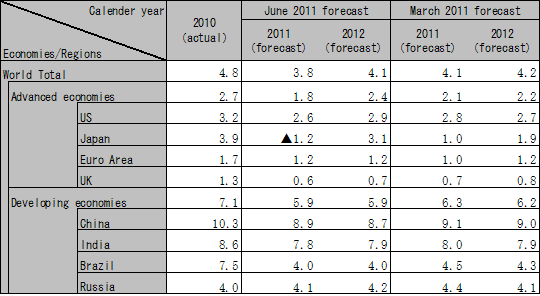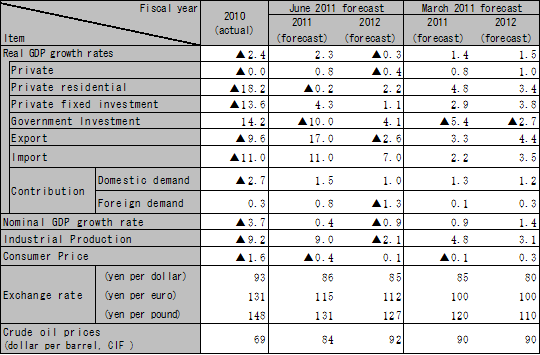Latest economic forecasts for Japan, the U.S., Europe, and China, etc
The earthquake and tsunami in the Pacific Coast of Tohoku region in Japan on March 11 damaged not only the Japanese economy but also the world economy. US automobile production slumped, and Chinese imports from Japan dropped sharply in April. According to the survey by the Ministry of Economy, Trade and Industry, Japanese manufacturing production is expected to make a V-shaped recovery starting from May and June. Still, production levels in the automobile industry in June is less than 80% of that in February. A recovery in production will not come before early autumn. Activities in the non-manufacturing sectors, which depends on consumer demand will be late to come back. The most urgent problem at this moment is the electric power shortage this summer. Government has ordered businesses and households in the Tohoku and Kanto regions to reduce power consumption by 15% from peak levels. Businesses and households are trying a variety of measures to shift peak usage and implement energy saving measures, such as adjusting working days and hours. We expect that such measures will hurt economic activities and reduce the annual real GDP by approximately 0.8%. Moreover, the Japanese economy is contingent on the uncertain situation that still affects the Fukushima Daiichi nuclear power plant. If stabilization of the plant does not proceed as planned, it is possible that economic stagnation will be prolonged. Political turmoil adds to uncertainties. Although we expect the Japanese economy to begin to recover in the latter half of this fiscal year, there is still a high degree of uncertainty.
The world economy from the financial crisis up until the last year took a ‘Two Speed Recovery' path, where the advanced countries, such as the US, Europe and Japan, were slow to recover in employment, and the emerging economies were growing rapidly, nearly overheating. Meanwhile, global imbalances in the current accounts stopped narrowing, and the commodity prices continued to rise. Now, the pace of recovery in the advanced countries is even slower, and the emerging economies began to slow down due to anti-inflation fighting measures. The sustainability of ‘Two Speed Recovery' is in question. Recovery may be sustained, if overheating economies transfer jobs to sluggish economies with the help of currency exchange rate adjustments. However, most of the overheating economies have export-oriented growth policies and economic structure, so they only allow very slow appreciation of their own currencies. We forecast a soft landing scenario where emerging economies will slow down (China: 10.3% GDP growth in CY2010, slowing to 8.9% in CY2011). However, a hard landing scenario is possible where growth stops abruptly in the emerging economies if too tight of a monetary policy is implemented.
The US will grow 2.6% in CY2011 (downward revision from the previous forecast: 2.8%). As the impact of the economic stimulus packages by the government begin to taper off, employment nearly stopped improving and the housing prices began to decline again. The private sector demand is very weak. The slow down is partly due to temporary factors like rising gasoline prices, floods, tornados, and the earthquake in Japan. We expect a slow down, but do not expect a double-dip recession. However, a recession may come about if the US government defaults on its debt payments, if political leaders fail to lift the federal debt limit. The sovereign debt crisis remains in Europe. While core countries, such as Germany, enjoy solid recovery thanks to increasing exports; peripheral countries are in a deep recession due to austerity measures and deflation which is, in essence, internal devaluation under the unified currency Euro. We expect economic growth of 1.2% for the EU, and 0.6% for the UK for CY2011.
Supply restrictions like power shortages and supply-chain disruption will continue to affect the Japanese economy in the first half of this fiscal year. Although reconstruction of buildings and houses started immediately after the Great Hanshin earthquake hit in 1995, it will start much later this time, because the tsunami washed away everything and complicated the ownership of land in the disaster area. The rebuilding plan will take a long time and consensus among the residents is needed. As for the reconstruction budgets, 4 trillion Yen for the 1st supplementary budget is already being implemented. We assume that additional 9 trillion yen for reconstruction will be included in the following budgets through FY2012. We also assume that government bonds are newly issued for funds of reconstruction budgets, and that tax will not be raised until FY2013. We expect that the Japanese economy will regain the momentum of recovery in early autumn, due to rebuilding demand for private facilities, dwellings, and public infrastructure. We expect GDP growth of -0.3% in FY 2011 (downward revision from previous forecast of 1.4%), and 2.9% GDP growth in FY2012. Can Japan change the national crisis into an opportunity to solve Japan's economic issues with the appropriate fiscal policy? Japan faces the moment of truth.

Note: Japanese numbers above are on calender year basis, but those in the table below are on a fiscal year basis
Source: Compiled by HRI from various sources. Forecasts by HRI

Source: Compiled by HRI from Cabinet Office "Natural economic accounting" and other sources. Forecasts by HRI